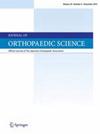联合 ATFL 和 CFL 损伤中孤立 ATFL 修复后直接测量距腓骨前韧带和小腿腓骨韧带的应变模式:尸体研究。
IF 1.4
4区 医学
Q3 ORTHOPEDICS
引用次数: 0
摘要
背景:尽管 20% 的慢性外侧踝关节失稳是由距骨胫骨前韧带 (ATFL) 和小腿腓骨韧带 (CFL) 联合损伤造成的,但使用关节镜韧带修复技术只对 ATFL 进行缝合。尽管一些生物力学和临床研究证明,孤立的 ATFL 修复术效果极佳,但之前的生物力学研究使用的系统只能进行间接估算。本研究的目的是通过直接测量合并 ATFL 和 CFL 损伤的尸体模型上修复后的 ATFL 和 CFL 应变模式来明确应变模式:方法:使用微型化韧带性能探针(MLPP)系统直接测量应变模式,将应变片插入5个尸体标本中正常和修复的ATFL和CFL纤维的中层,以测量踝关节轴向和三维运动中的应变模式:结果:正常和修复后的 ATFL 在轴向和三维运动中表现出相似的应变模式。在踝关节轴向运动范围内,修复后的CFL显示出与正常CFL几乎相似的应变模式,但应变随着跖屈或背屈角度的增加而增加,跖屈30°时最大值为100,背屈15°时应变值为17-55/100。在三维运动过程中,修复后的CFL在背屈内翻时低于最大值100,在跖屈内翻时应变较小(7-38/100):结论:修复后的 CFL 显示的应变模式与正常应变模式并不完全一致;不过,虽然没有直接修复,但它确实具有某种程度的类似正常应变模式的张力。本文章由计算机程序翻译,如有差异,请以英文原文为准。
Directly measured strain patterns of the anterior talofibular and calcaneofibular ligaments after isolated ATFL repair in a combined ATFL and CFL injury: A cadaver study
Background
Even though 20% of chronic lateral ankle instability results from a combined anterior talofibular ligament (ATFL) and calcaneofibular ligament (CFL) injury, only the ATFL is sutured using arthroscopic ligament repair techniques. Although some biomechanical and clinical studies have proved that isolated ATFL repair yields excellent results, previous biomechanical studies were performed using systems that only allow indirect estimations. The purpose of this study was to clarify strain patterns by directly measuring repaired ATFL and CFL strain patterns on cadaveric models that underwent isolated ATFL repair of a combined ATFL and CFL injury.
Methods
The miniaturization ligament performance probe (MLPP) system was used for directly measuring the strain patterns to insert the strain gauges into the mid-substance of normal and repaired ATFL and CFL fibers in five cadaveric specimens to allow measurement of strain patterns in the axial and three-dimensional motion of the ankle.
Results
The normal and repaired ATFL showed similar strain patterns in axial and three-dimensional motions. During the axial range of motion of the ankle, the repaired CFL showed a strain pattern almost similar to that of normal CFL, but the strain increased as the plantar flexion or dorsiflexion angle increased to the maximum value of 100 at 30° plantarflexion or strain values of 17–55/100 at 15°dorsiflexion. During three-dimensional motion, the repaired CFL was under the maximum value of 100 during dorsiflexion-inversion and exhibited less strain (7–38/100) during plantar flexion-eversion.
Conclusion
The repaired CFL did not show a strain pattern that was completely consistent with a normal strain pattern; however, it did have some degree of tension similar to a normal strain pattern, even though it was not directly repaired.
求助全文
通过发布文献求助,成功后即可免费获取论文全文。
去求助
来源期刊

Journal of Orthopaedic Science
医学-整形外科
CiteScore
3.00
自引率
0.00%
发文量
290
审稿时长
90 days
期刊介绍:
The Journal of Orthopaedic Science is the official peer-reviewed journal of the Japanese Orthopaedic Association. The journal publishes the latest researches and topical debates in all fields of clinical and experimental orthopaedics, including musculoskeletal medicine, sports medicine, locomotive syndrome, trauma, paediatrics, oncology and biomaterials, as well as basic researches.
 求助内容:
求助内容: 应助结果提醒方式:
应助结果提醒方式:


